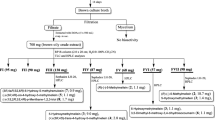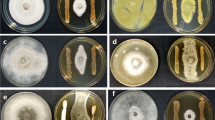Abstract
The citrus black spot (CBS), caused by Phyllosticta citricarpa, is one of the most important citrus diseases in subtropical regions of Africa, Asia, Oceania, and the Americas, and fruits with CBS lesions are still subject to quarantine regulations in the European Union. Despite the high application of fungicides, the disease remains present in the citrus crops of Central and South America. In order to find alternatives to help control CBS and reduce the use of fungicides, we explored the antifungal potential of endophytic actinomycetes isolated from the Brazilian medicinal plant Vochysia divergens found in the Pantanal biome. Two different culture media and temperatures were selected to identify the most efficient conditions for the production of active secondary metabolites. The metabolites produced by strain Microbacterium sp. LGMB471 cultured in SG medium at 36 °C considerably inhibited the development of P. citricarpa. Three isoflavones and five diketopiperazines were identified, and the compounds 7-O-β-d-glucosyl-genistein and 7-O-β-d-glucosyl-daidzein showed high activity against P. citricarpa, with the MIC of 33 μg/mL and inhibited the production of asexual spores of P. citricarpa on leaves and citrus fruits. Compounds that inhibit conidia formation may be a promising alternative to reduce the use of fungicides in the control of CBS lesions, especially in regions where sexual reproduction does not occur, as in the USA. Our data suggest the use of Microbacterium sp. LGMB471 or its metabolites as an ecological alternative to be used in association with the fungicides for the control of CBS disease.



Similar content being viewed by others
References
Agostini JP, Peres NA, Mackenzie SJ, Adaskaveg JE, Timmer LW (2006) Effect of fungicides and storage conditions on postharvest development of citrus black spot and survival of Guignardia citricarpa in fruit tissues. Plant Dis 90:1419–1424
Azzouzi S, Zaabat N, Medjroubi K et al (2014) Phytochemical and biological activities of Bituminaria bituminosa L. (Fabaceae). Asian Pac J Trop Med 7:481–484
Barrow CJ, Sun HH (1994) Spiroquinazoline, a novel substance P inhibitor with a new carbon skeleton, isolated from Aspergillus flavipes. J Nat Prod 57:471–476
Cartens E, Linde CC, Slabbert R et al (2017) A global perspective on the population structure and reproductive system of Phyllosticta citricarpa. Phytopathology 107:758–768
Carvalho GFG, Ferreira MC, Lasmar O (2014) Control of citrus black spot and juice quality after spraying fungicide in contrasting water volumes. Asp Appl Biol 122:431–436
Chang TS, Ding HY, Tai SS, Wu CY (2007) Metabolism of the soy isoflavones daidzein and genistein by fungi used in the preparation of various fermented soybean foods. Biosci Biotechnol Biochem 71:1330–1333
Cheng Q, Li N, Dong L, Zhang D, Fan S, Jiang L, Wang X, Xu P, Zhang S (2015) Overexpression of soybean isoflavone reductase (GmLFR) enhances resistance to Phytophthora sojae in soybean. Front Plant Sci 6. https://doi.org/10.3389/fpls.2015.01024
Er HL, Roberts PD, Marois JJ, van Bruggen AHC (2013) Potential distribution of citrus black spot in the United States based on climatic conditions. Eur J Plant Pathol 137:635–647
Er HL, Hendricks K, Goss EM et al (2014) Isolation and biological characterization of Guignardia species from citrus in Florida. J Plant Pathol 96:43–55
EU (2015) Guidelines for Phyllosticta citricarpa in the Union Territory. https://gd.eppo.int/taxon/GUIGCI/distribution/BD
Farrar K, Bryant D, Cope-Selby N (2014) Understanding and engineering beneficial plant-microbe interactions: plants growth promotion in energy crops. Plant Biotechnol J 12:1193–1206
Fedoreyev SA, Bulgakov VP, Grishchenko OV, Veselova MV, Krivoschekova OE, Kulesh NI, Denisenko VA, Tchernoded GK, Zhuravlev YN (2008) Isoflavonoid Composition of a Callus Culture of the Relict Tree Maackia amurensis Rupr. et Maxim. J Agric Food Chem 56: 7023–7031
Fernández E, Weissbach U, Sánchez RC et al (1998) Identification of two genes from Streptomyces argillaceus encoding glycosyltransferases involved in transfer of a disaccharide during biosynthesis of the antitumor drug mithramycin. J Bacteriol 180:4929–4937
Fialho MB, de Andrade A, Bonatto JMC, Salvato F, Labate CA, Pascholati SF (2016) Proteomic of the phytopathogen Phyllosticta citricarpa to antimicrobioal volatile organic compounds from Saccharomyces cerevisiae. Microbiol Res 183:1–7
Gao FK, Dai CC, Liu XZ (2010) Mechanisms of fungal endophytes in plant protection against pathogens. Afr J Microbiol Res 4:1346–1351
Glienke C, Pereira OL, Stringari D, Fabris J, Kava-Cordeiro V, Galli-Terasawa L, Cunnington J, Shivas RG, Groenewald JZ, Crous PW (2011) Endophytic and pathogenic Phyllosticta species, with reference to those associated with citrus black spot. Personia 26:47–56
Gos FMWR, Savi DC, Shaaban K et al (2017) Antibacterial activity of endophytic actinomycetes isolated from the medicinal plant Vochysia divergens (Pantanal, Brazil). Front Microbiol 8:1642
Guarnaccia V, Groenewald JZ, Li H, Glienke C, Carstens E, Hattingh V, Fourie PH, Crous PW (2017) First report of Phyllosticta citricarpa and description of two new species, P. paracapitalensis and P. paracitricarpa, from citrus in Europe. Stud Mycol 87:161–185
Hazato T, Naganawa H, Aoyagi KTA, Umezawa H (1979) Β-galactosidade-inhibiting new isoflavonoids produced by actinomycetes. J Antibiot 32:217–222
Hokama Y, Savi DC, Assad B et al (2016) Endophytic fungi isolated from Vochysia divergens in the Pantanal, Mato Grosso do Sul: diversity, phylogeny and biocontrol of Phyllosticta citricarpa. In: Hughes E (ed) Endophytic fungi: diversity, characterization and biocontrol, 4th edn. Nova Publishers, Hauppauge, pp 1–25
Junaid JM, Dar NA, Bhat TA, Bhat AH, Bhat AB (2013) Commercial biocontrol agents and their mechanisms of action in the management of plant pathogens. Int J Modern Plant Anim Sci 1:39–57
Kalinovskaya NI, Romanenko LA, Kalinovsky AI (2017) Antibacterial low-molecular-weight compounds produced by the marine bacterium Rheinheimera japonica KMM 9513T. Antonie Van Leeuwenhoek 110:719–726
Kamil I, Gencbay T, Zedmir-Kocak F, Cil E (2014) Molecular identification of different actinomycetes isolated from east black sea region plateau soil by 16S rDNA gene sequencing. Afr J Microbiol Res 8:878–887
Kotzé JM (1981) Epidemiology and control of citrus black spot in South Africa. Plant Dis 65:249–292
Lee JH, Jeong SW, Cho YA, Park S, Kim YH, Bae DW, Chung JI, Kwak YS, Jeong MJ, Park SC, Shim JH, Jin JS, Shin SC (2013) Determination of the variations in levels of phenolic compounds in soybean (Glycine max Merr.) sprouts infected by anthracnose (Colletotrichum gloeosporioides). J Sci Food Agric 93:3081–3086
Maggione CS (1998) Planejamento e custo citricola. Citricultura Atual 1:5–6
Mariduena-Zavala MG, Er HL, Goss EM et al (2014) Genetic variation among Phyllosticta strains isolated from citrus in Florida that are pathogenic or nonpathogenic to citrus. Trop Plant Pathol 39:119–128
Martins MB, Carvalho I (2007) Diketopiperazines: biological activity and synthesis. Thetrahedron 63:9923–9932
Olveira CM, Silva GH, Regasini LO, Zanardia LM, Evangelista AH, Young MCM, Bolzania VS, Araujo AR (2009) Bioactive Metabolites Produced by Penicillium sp.1 and sp.2, Two Endophytes Associated with Alibertia macrophylla (Rubiaceae). Z Naturforsch 64:824–830
Peña LC, Jung LF, Savi DC et al (2016) A Muscodor strain isolated from Citrus sinensis and its production of volatile organic compounds inhibiting Phyllosticta citricarpa. J Plant Dis Protect 124:349–360
Perez-Victoria I, Martin J, Gonzalez-Menendez V, de Pedro N, El Aouad N 2012 Isolation and structural elucidation of cyclic tetrapeptides from Onychocola sclerotica. J Nat Prod 75:1210–1214
Perryman AM, Clark SJ, West JS (2014) Splash dispersal of Phyllosticta citricarpa conidia from infected citrus fruit. Sci Rep 4:1–8
Pickenhagen W, Dietrich P, Keil B, Polonsky J, Nouaille F, Lederer E (1975) Identification of the bitter principle of cocoa. Helv Chim Acta 58:1078–1086
Prasad C (1995) Bioactive cyclic dipeptides. Peptides 16:151–164
Ryan RP, Dow JM (2008) Diffusible signals and interspecies communication in bacteria. Microbiol 154:1845–1858
Santos PJC, Savi DC, Gomes RR et al (2016) Diaporthe endophytica and D. terebinthifolii for biological control of Phyllosticta citricarpa. Microbiol Res 186:153–160
Savi DC, Shaaban KA, Vargas N, Ponomareva LV, Possiede YM, Thorson JS, Glienke C, Rohr J (2015) Microbispora sp. LGMB259 endophytic actinomycete isolated from Vochysia divergens (Pantanal, Brazil) producing B-carbolines and indoles with biological activity. Curr Microbiol 70:345–354
Schubert TS, Dewdney MM, Peres NA, Palm ME, Jeyaprakash A, Sutton B, Mondal SN, Wang NY, Rascoe J, Picton DD (2012) First report of Guignardia citricarpa assocaited with citrus black spot on sweet orange (Citrus Sinensis) in North America. Plant Dis 96:1225–1229
Schutte GC, Mansfield RI, Smit H, Beeton KV (2003) Application of azoxystrobin for control of benomyl-resistant Guignardia citricarpa on ‘Valencia’ oranges in South Africa. Plant Dis 87:784–788
Shaaban KA, Srinivasan S, Kumar R, Damodaran C, Rohr J (2011) Landomycins, P.-W., cytotoxic angucyclines from Streptomyces cyanogenus S-136. J Nat Prod 74:2–11
Shaaban KA, Shepherd MD, Ahmed TA, Nybo SE, Leggas M, Rohr J (2012) Pyramidamycins A-D and 3-hydroxyquinoline-2-carboxamide; cytotoxic benzamides from Streptomyces sp. DGC1. J Antibiot 65:615–622
Silva GJ Jr, Scapin MS, Silva FP et al (2016) Spray volume and fungicide rates for citrus black spot control based on tree canopy volume. Crop Prot 85:38–45
Tonial F, Maia BHLNS, Sobottka AM et al (2017) Biological activity of Diaporthe terebinthifolii extracts against Phyllosticta citricarpa. FEMS Microbiol Lett 1:364
U.S. EPA (2012) U.S. Environmental Protection Agency—risk assessment for safety of orange juice containing fungicide carbendazim, http://www.epa.gov/pesticides/factsheets/chemicals/carbendazim-fs.htm
Wang NY, Zhang K, Huquet-Tapia JC, Rollins JA, Dewdney MM (2016) Mating type and simple sequence repeat markers indicate a clonal population of Phyllosticta citricarpa in Florida. Phytopathology 106:1300–1310
Yan PS, Song Y, Sakuno E, Nakajima H, Nakagawa H, Yabe K (2004) Cyclo(Lleucyl-lprolyl) produced by Achromobacter xylosoxidans inhibits aflatoxin production by Aspergillus parasiticus. Appl Environ Microbiol 70:7466–7473
Yu J, Bi X, Yu B, Chen D (2016) Isoflavones: anti-inflamatory benefit and possible caveats. Nutrients 8. https://doi.org/10.3390/nu8060361
Acknowledgements
This work was supported by NIH grants CA 91091 and GM 105977 and an Endowed University Professorship in Pharmacy to J.R. University of Kentucky Markey Cancer Center, the National Center for Advancing Translational Sciences (UL1TR001998) and the NIH grants R01 GM115261 to J.S.T. Fundação Araucária grant 441/2012 – 23510, Conselho Nacional de Desenvolvimento Científico e Tecnológico – Brazil grant 486016/2011-0 to C.G.
Author information
Authors and Affiliations
Corresponding authors
Additional information
Publisher’s Note
Springer Nature remains neutral with regard to jurisdictional claims in published maps and institutional affiliations.
Electronic supplementary material
ESM 1
(DOCX 2151 kb)
Rights and permissions
About this article
Cite this article
Savi, D.C., Shaaban, K.A., Gos, F.M.W. et al. Secondary metabolites produced by Microbacterium sp. LGMB471 with antifungal activity against the phytopathogen Phyllosticta citricarpa. Folia Microbiol 64, 453–460 (2019). https://doi.org/10.1007/s12223-018-00668-x
Received:
Accepted:
Published:
Issue Date:
DOI: https://doi.org/10.1007/s12223-018-00668-x




